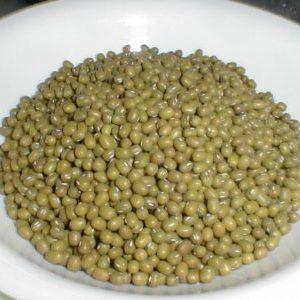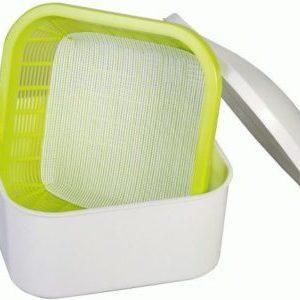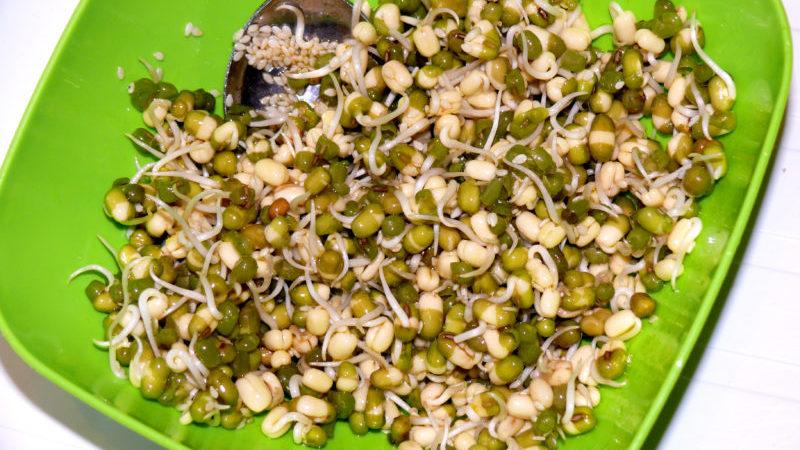A real find for those losing weight and raw foodists: how to germinate mung bean at home and how to eat it correctly
Mung bean is widespread in many countries of the world. Soups are made from its beans, a variety of side dishes are prepared, and from those ground into flour - pancakes, pasta, funchose (the so-called glass noodles), cream, ice cream and even drinks. This product came to us from Asian cuisines, and even in Russia mung bean is no longer uncommon.
What is mung bean
Mash (lat. Vigna radiata), or Indian bean, or mung, is an annual plant of the Vigna genus of the Legume family. Sometimes it is mistakenly called green bean, claiming that mung bean sprouts are very beneficial for the human body.

An ignorant reader may be confused, since green beans are also called green beans or asparagus beans. Mung bean is not a bean, although previously it was classified in this genus and called golden bean (lat. Phaseolus aureus, Phaseolus radiatus).
Mung beans have green beans that really look like small beans beans. The length of the beans ranges from 0.3 to 0.6 cm.
The historical homeland of mung bean is India. Since ancient times, Indians have cultivated mung bean, calling it “mung”. Fossilized mung beans have been discovered in central India and date back to 1500-1000 BC. e.
Useful properties of mung bean
The beneficial properties of mung bean are due to its composition:
- Polyunsaturated vegetable fats protect the heart and blood vessels and have a positive effect on metabolism.
- B vitamins have a beneficial effect on the condition of the skin and hair.
- Folic acid is indispensable for pregnant and lactating women, for the normal development of the fetus and the optimal composition of breast milk.
- Fiber helps the gastrointestinal tract and helps remove toxins and harmful substances from the body.
- Nanocoenzymes actively resist the negative effects of the environment on the skin, which makes cosmetic procedures using the plant one of the means to prolong the youth of the skin.
- Doctors advise diabetics to eat mung bean sprouts regularly as it maintains normal blood sugar levels.
- Chinese medicine uses a decoction of mung bean seeds for a whole list of diseases: digestive disorders, colds, swelling. Chinese traditional healers treat food poisoning with mung bean, in particular poisoning by mushrooms or poisonous plants. In their opinion, mung bean helps with poisoning by pesticides and heavy metals.
- These beans also accelerate the healing of thermal burns, have a diuretic effect, and remove harmful substances from the intestines.
Important! Unfortunately, nutritionists do not recommend eating mung bean for obese people, since its energy value is very high - 300 kcal per 100 g.
But sprouts are a real godsend for those who want to lose weight. When sprouting, the beneficial qualities of beans are not only preserved, but even increased. The amount of protein in sprouts doubles, vitamin C increases seven times, the total content of antioxidants increases 5 times, and the energy value of sprouts, on the contrary, decreases 10 times and amounts to only 30 kcal per 100 g.
Where to buy mung bean and how to store it
 Dry mung bean can be purchased in grocery stores, supermarkets, markets or ordered online.It’s more difficult with sprouted ones - you can really only find them in supermarkets in large cities. Should I be upset about this? No! Mung bean sprouted at home is fresher and healthier than store-bought. It is not at all difficult to germinate it yourself.
Dry mung bean can be purchased in grocery stores, supermarkets, markets or ordered online.It’s more difficult with sprouted ones - you can really only find them in supermarkets in large cities. Should I be upset about this? No! Mung bean sprouted at home is fresher and healthier than store-bought. It is not at all difficult to germinate it yourself.
The price of mung bean varies greatly - from 100 (on the market) to 450 rubles per 1 kg.
If you bought beans in a store in special packaging, they can be stored for the entire specified period provided the packaging is unopened. If the package is opened, it is better to put it in the refrigerator.
Important! During storage, you should periodically sort through the beans, inspecting them for plaque or unpleasant odor.
It is not recommended to store packages of beans near heating devices (batteries, gas stoves, etc.), as the temperature and humidity of the air inside the package may increase, which will lead to rotting.
If you purchased beans at the market, when you get home, sort them out. Wrinkled or damaged seeds must be removed. The storage container should contain only completely dry and undamaged beans.
Pulses are stored well in canvas bags, previously boiled in a concentrated saline solution, thoroughly dried and ironed.
How to germinate mung bean at home
To germinate mung bean at home use:
- Special equipment – sprouter seed germinator. The price for them ranges from 300 to 3000 rubles.
- Any suitable size bowl, plate or other container.
Of course, special equipment with an automatic irrigation system, maintaining temperature and air humidity will have a beneficial effect on the quality of seedlings.
However, given that mung bean seeds are large and germinate well and quickly, it is quite possible to get by with a deep soup plate, salad bowl or bowl.
What is needed for germination
You will need:
- 70 g or 3 tablespoons of dry mung beans (which will yield 210 g of sprouts after 31 hours);
- deep and wide dishes (choose them taking into account the fact that the number of beans triples during germination);
- 125 ml of boiling water.
Step-by-step instructions for germination
How to germinate mung beans at home:
- Sort the beans, discarding any debris and dry beans.
- Rinse under running water.
- Arrange the beans in the sprouter, preferably in one layer.
- Boil 125 ml of water and pour boiling water over them. Beans will not suffer from short-term exposure to boiling water, but pathogenic microflora will be destroyed.
- Place the dishes in a warm, wind-free place.
- After 8 hours, the beans will have absorbed almost all the liquid. Then you need to add more water, this time cooled and boiled, so that the beans are completely covered.
- During the day, you need to make sure that the beans do not dry out, but it is also not recommended to overfill them with water.
- Periodically rinse the beans under cold running water.
- After 31 hours, the length of the bean sprouts will be 0.3-0.5 cm.
- Continue to carefully water the mung beans, making sure that the seeds do not dry out.
- After 96 hours, the sprouts are ready to eat.
- Now you need to rinse the mung beans, carefully removing the green shells, and eat.
Note. The maximum benefit comes from seedlings no longer than 1 cm.
How to eat mung bean sprouts
Despite the fact that mung bean, unlike other legumes, contains a smaller amount of oligosaccharides that cause gas formation and complicate the digestion process, if digestion is impaired, its excessive consumption can cause dyspepsia and flatulence.
There is evidence in the literature that mung bean should be introduced into the diet with caution for pregnant and nursing mothers, children under 6 years of age, and people with allergies. Folic acid (vitamin B9), which is rich in sprouts, provides protection for the mother during pregnancy, improves the health of babies, and also prevents the risk of early birth and neural tube defects.
Attention! Consult your doctor before use.

General recommendations
It is important to observe moderation when consuming sprouts. The daily intake should not exceed 60 g or 3 tablespoons.
How to improve the absorption of mung bean sprouts and reduce gas formation:
- Add spices: turmeric, ginger, asafoetida, coriander, pepper.
- Eat no more than 3 tablespoons per day.
- Try to eat sprouts only at lunchtime.
- Within 40 minutes after taking it, do not drink cold or too much.
- Try not to combine with animal products.
- Remember that any protein food requires an active lifestyle.
How to store sprouted mung bean
Store the sprouts for no more than 2 days in the refrigerator in a slightly opened container. Avoid overwatering, which can lead to rotting, but don’t overdry them either. Be sure to rinse the sprouts before eating.
Read also:
Recipes
Sprouted mung bean cutlets
Grind 1 cup of sprouts and 70 g of pre-boiled rice in a blender.Fry cumin, coriander and asafoetida, 1 teaspoon each, for 1-2 minutes in a frying pan, add 1 grated carrot to them and simmer for another 5 minutes. Combine the mixture of sprouts and rice with spices. The minced meat is ready. Add salt to taste, form cutlets and fry in a pan or steam.
Hearty smoothie
500 ml of water, a large handful of spinach, celery or parsley, 2 bananas, 2 tablespoons of mung bean sprouts, 5 dates add to a blender and blend.
Korean usage
In Korea, lightly boiled (less than 1 minute) mung sprouts are often served as a separate dish. Then cool and mix with sesame oil, garlic, salt, and other ingredients.
For lovers of hot and spicy Korean salad recipe:
Ingredients:
- 3 tablespoons of sprouts;
- 1 medium onion;
- 2 cloves of garlic;
- 1 teaspoon sesame seeds (white or black, preferably black and white);
- 1/3 teaspoon of monosodium glutamate (optional), a pinch of granulated sugar, hot pepper to taste, jalapeno (depend on your taste), if you don’t have fresh hot pepper, take coarsely ground chili, 2 peas of freshly crushed black pepper.
Preparation:
- Lightly rinse the mung bean sprouts and place in boiling water. After boiling, cook for 1 minute, then drain the water and drain the sprouts in a colander.
- At the same time, throw the black and white sesame seeds into a pre-heated frying pan and fry a little until the white sesame seeds are browned.
- Quickly discard the seeds into the prepared plate to prevent them from overcooking.
- Chop the onion as finely as possible and pour boiling water over it for 10-15 seconds. Chop the garlic.
- Combine onions, garlic, sesame seeds, cooled sprouts and add spices.Mix everything thoroughly and pour in hot, preferably sesame, oil and mix again.
- Before eating, let the salad sit for 15-20 minutes.
Conclusion
Mung bean sprouts are an incredibly healthy and easily digestible product. But despite this, they are recommended to be used with other products. There is no need to take sprouts as the basis of nutrition.